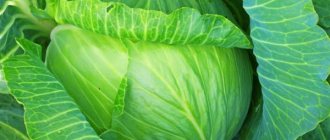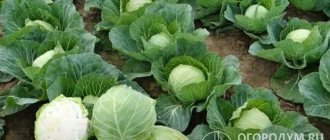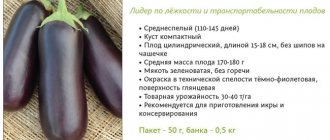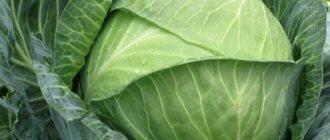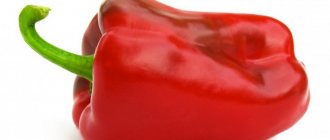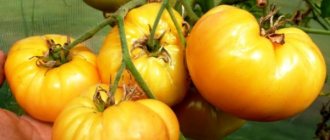Vegetable growing » Cabbage
0
1055
Article rating
Kira Stoletova
White cabbage Kevin F1 is an early hybrid variety that has a short growing season. The seedlings are resistant to cold. It is grown in open ground and greenhouses. The vegetable heads have a pleasant green tint and are firm and round in shape. The variety is able to maintain its presentation for a long time.
Characteristics of cabbage variety Kevin f1
Cabbage seedlings
It is important to observe the temperature regime.
Seedlings are grown under film or in greenhouse conditions. The early variety is whimsical in matters of lighting, heating, uniform watering, and ventilation.
The optimal form of growing seedlings is cassette
When choosing seeds of the early variety Kevin f1, pay attention to the packaging: labeling, batch number, expiration date, absence of external damage. Ready seedlings are transplanted into the ground when the plant has up to 4 leaves with a height of 10 cm
Seeds can also be sown in the ground. The depth of the hole is about 2 cm. The temperature regime must be observed. When transplanting seedlings, the root system is injured and survival rate deteriorates.
Seedling care and harvesting
The use of ready-made peat substrates improves the quality of seedlings. Ready-made complex substrates contain all the necessary nutrients, there are no weeds or pathogenic organisms.
Seedlings must be watered regularly. After the first leaves appear, the bushes are treated with chemical fertilizer against cruciferous flea beetles and spring flies. Mandatory treatment against weeds.
Storage of early variety
Favorable storage conditions are air temperature 0°C and humidity 90%. The upper leaves will prevent the head of cabbage from drying out and will retain its presentation. Early varieties of cabbage are vegetables with a short shelf life.
Advantages and disadvantages of cabbage
It’s not for nothing that Dutch cabbage varieties are the most popular: high demand is ensured by many positive aspects of the varieties. Benefits of cabbage:
- gives a large harvest, up to 10-11 kg per square meter;
- one head of cabbage can reach 7 kg;
- widely used in cooking: fruits can be stewed, boiled, pickled, or eaten fresh;
- unpretentious culture;
- most varieties are adapted for Russian conditions, even for the severe weather of the north;
- The crop is resistant to drought and even in cold summers produces a decent harvest.
Flaws:
- additional treatment with herbicides and insecticides is required;
- with insufficient care, productivity drops sharply;
- Some varieties do not store well and may crack.
Advice. When purchasing, pay attention to the characteristics of a particular variety. They vary greatly depending on the type of cabbage.
Characteristics of the variety
Mirror F1 is a hybrid variety. Its advantage is a consistently high yield. Even with high humidity or, conversely, dry and hot weather, Mirror produces a good harvest.
A distinctive property of the variety is resistance to bolting. Heads of cabbage that are not harvested at the stage of technical maturity increase in size, but do not shoot.
Description of the head of cabbage
The head of cabbage grows of medium size. Its weight does not exceed 3 kg. The leaves do not fit tightly together and form a rounded leaf, elongated at the base of the forks.
Description of Cabbage Mirror:
- light green color at the stage of technical maturity of the vegetable;
- delicate veins on the leaves that do not become rough over time;
- a thin elongated stump suitable for food.
Cabbage leaves contain a large amount of glucose. This makes them sweet and juicy. The vegetable is also rich in iodine, selenium, vitamins A, B and C.
Application
Mirror cabbage is most often used fresh. It is sweet and juicy, so it is suitable for preparing salads and vegetable slices. Cold snacks are prepared from the vegetable with the addition of fresh cucumber, carrots, radishes and onions. This preserves the maximum of useful vitamins and minerals, but such salads can be consumed no later than 6-7 hours after preparation.
Cabbage is also suitable for preparing hot dishes. You can make meat or vegetable cabbage rolls, hot side dishes, or stew vegetables with tomatoes and carrots. This variety is not suitable for winter preservation, pickling or pickling. The delicate structure of the leaf loses its flavor and becomes too soft. Such dishes spoil quickly.
Mid-season varieties
Among the varieties with an average ripening speed, the most popular are “Langedijker” and “Krautkaiser f1”. The “f1” mark is typical for all hybrid varieties.
You may be interested in: Dates for planting cauliflower seedlings in 2022 according to the moon Favorable days for broccoli for seedlings in 2022 Planting Chinese cabbage for seedlings in 2022 according to the lunar calendar
"Langedijker" produces traditional heads of cabbage with medium density. The plant is suitable mainly for salads and requires softening. Heads of cabbage keep well, but worse than Bingo. Ripening time is about 2.5 months. This variety is often found in canned food, but is no less often consumed fresh.
Advice. If you get a bad, hard harvest, use it for processing: ferment or stew.
The hybrid variety "Krautkaiser f1", like most hybrids, is not afraid of diseases. Thanks to this, it does not need to be treated with special compounds; it is enough to use herbicides. This species has an almost perfect round shape and high head density. The fruits are mainly used for processing. Sauerkraut is often made from them. This variety is recommended to be stewed or added to soup.
Another hybrid deserves special attention - cabbage Bronco f1. It is suitable for growing in difficult conditions (cold, drought, temperature changes). Bronko cabbage is white cabbage and produces a yield of 3-4 kg per seedling. Seeds of medium price category.
A promising find from agro - cabbage Kevin F1: description and characteristics
Cabbage Kevin F1 is a productive and promising early-ripening hybrid. Over the years of cultivation, it has gained many fans. Juicy, crispy forks beg to be added to salads and aromatic first courses (the leaves contain a high level of sugar).
| Landing location | Ripening time | View | Purpose | Origin | Maturation period | Weight |
| Greenhouse, Open ground | Early ripening | White cabbage | Fresh | Hybrid | 51-53 | 1,5-1,9 |
Description and characteristics of the variety
Kevin early cabbage has good cold resistance and tolerates short-term frosts on the soil. It is cultivated in open beds, in greenhouse structures (under film, agrofibre).
Kevin cabbage is valued for its early ripening and is a self-pollinating hybrid. The forks are aligned and homogeneous and have a stable mass.
White cabbage Kevin F1 has the following characteristic features:
- average weight 1.5-1.9 kg;
- green, emerald coloring;
- when cut, the core is light yellow;
- round shape;
- classic taste;
- good juiciness and crunchiness.
The hybrid variety is valued for its marketability and low waste content. Used fresh for making borscht and soup.
Advantages and disadvantages
- resistance of forks to cracking and glass transition;
- frost tolerance (seedlings within -4 degrees, bushes with formed heads up to -7 degrees);
- adaptability to various weather changes;
- stress resistance;
- resistance to a complex of infections;
- excellent product and taste indicators;
- extended shelf life.
Minuses:
the importance of systematic watering
Landing
Optimal temperature for planting depending on conditions:
- on unprotected beds 3-4 degrees;
- in greenhouse structures 19-21 degrees.
After rooting the seedlings, the temperature can be lowered to 14-16 degrees.
Growing and care
The hybrid loves moisture and systematic watering. For cultivation, clayey and loamy soils are selected (they ripen faster in such soils due to warming), where they are first added per 1 m2:
- compost 7-8 kg;
- phosphorus-potassium mixture 40-50 g;
- ash 3 tbsp.
When grown in greenhouses:
- water evenly;
- ventilate 2 times for 15 minutes;
- arrange additional lighting;
- observe temperature conditions.
The hybrid needs preventive protection from insect pests:
The heads are cut off by hand or mass mechanized harvesting is carried out over large areas.
Description and characteristics of the variety
Kevin early cabbage has good cold resistance and tolerates short-term frosts on the soil. It is cultivated in open beds, in greenhouse structures (under film, agrofibre).
Kevin cabbage is valued for its early ripening and is a self-pollinating hybrid. The forks are aligned and homogeneous and have a stable mass.
The growing season lasts 51-53 days.
White cabbage Kevin F1 has the following characteristic features:
- average weight 1.5-1.9 kg;
- green, emerald coloring;
- when cut, the core is light yellow;
- round shape;
- classic taste;
- good juiciness and crunchiness.
The hybrid variety is valued for its marketability and low waste content. Used fresh for making borscht and soup.
Characteristics of cabbage variety Kevin f1
White cabbage Kevin F1 is an early hybrid variety that has a short growing season. The seedlings are resistant to cold. It is grown in open ground and greenhouses. The vegetable heads have a pleasant green tint and are firm and round in shape. The variety is able to maintain its presentation for a long time.
Characteristics of cabbage variety Kevin f1
Characteristics of the variety
Kevin cabbage is a common early variety. Seeds require fertilizers and special care. Marking F1 is a self-pollinating hybrid, the heads of cabbage have the same shape, stable weight, and even leaf structure.
Brief description of Kevin cabbage:
| View | Variety | Ripening period | Head weight | External characteristics | Growing season |
| White cabbage | Hybrid | Early | 1.5-1.9 kg | Color green, yellow in cross section. Round shape. | 51-53 days |
The cabbage variety Kevin has high yield and low waste. The head of cabbage is resistant to glass transition and cracking.
Growing technique
The white cabbage variety can withstand frost: seedlings - 4°C, formed heads - up to 7°C. Seeds germinate in open and closed ground.
| Growth temperature in open ground | Temperature for greenhouse conditions |
| From 3°C to 4°C | From 19°C to 21°C |
In greenhouse growth conditions, after the seedlings have taken root, the temperature can be reduced to 14°C-17°C. Hot conditions and drought stop the growth and development of the crop. The variety needs high humidity and systematic watering.
Early varieties, including Kevin F1, germinate best in clay soil. It warms up well, so the heads ripen faster. All types of white cabbage love sunlight.
Top dressing
According to the description, Kevin's cabbage needs feeding. Mineral and organic fertilizers increase the yield of the variety. Signs of poor soil condition:
- old type of cabbage leaf;
- pale green hue of the head of cabbage;
- twisted and dry edge of the top sheets;
- external underdevelopment of the head of cabbage;
- yellow and orange spots;
- the head of cabbage stops ripening.
The soil needs nitrogen fertilization. It is best to introduce additional nutrition into the root system, repeat 2-3 times during the entire ripening period.
Diseases, excessive chemical protection, drought and excess moisture, too low air temperatures, as well as pests deprive half of the harvest.
Cabbage seedlings
It is important to observe the temperature regime
Seedlings are grown under film or in greenhouse conditions. The early variety is whimsical in matters of lighting, heating, uniform watering, and ventilation.
The optimal form of growing seedlings is cassette
When choosing seeds of the early variety Kevin f1, pay attention to the packaging: labeling, batch number, expiration date, absence of external damage. Ready seedlings are transplanted into the ground when the plant has up to 4 leaves with a height of 10 cm
Seeds can also be sown in the ground. The depth of the hole is about 2 cm. The temperature regime must be observed. When transplanting seedlings, the root system is injured and survival rate deteriorates.
Seedling care and harvesting
The use of ready-made peat substrates improves the quality of seedlings. Ready-made complex substrates contain all the necessary nutrients, there are no weeds or pathogenic organisms.
Seedlings must be watered regularly. After the first leaves appear, the bushes are treated with chemical fertilizer against cruciferous flea beetles and spring flies. Mandatory treatment against weeds.
Storage of early variety
Favorable storage conditions are air temperature 0°C and humidity 90%. The upper leaves will prevent the head of cabbage from drying out and will retain its presentation. Early varieties of cabbage are vegetables with a short shelf life.
Useful properties of cabbage
In folk medicine, cabbage leaves are used as an anti-inflammatory agent. The applied compress will relieve swelling and pain.
Vitamin C is a natural antioxidant. The chemical composition of the vegetable has the most stable form, so the vitamin does not lose its abilities during fermentation and heat treatment.
Late varieties
Late varieties are usually combined with early ones so that the farm can sell the crop throughout the summer and fall. Late-ripening species are good for the northern regions of central Russia; they grow well in greenhouses.
The most popular types:
- Bartolo;
- Portula;
- cabbage Jubilee f1;
- Ammon.
"Bartolo" has two forms: hybrid and original. Farmers prefer the hybrid variety because it is disease resistant. The heads of cabbage have an oval, slightly elongated shape and are distinguished by a light shade (light green, turning into white). They are stored on shelves for a long time, and even longer in warehouses with special storage conditions. The variety is notable for its large weight, on average 3 kg.
Interesting. The more the head of cabbage weighs, the juicier the leaves are.
"Jubilee" grows up to 120 days, has a gray-green tint of foliage. The leaves are medium-sized, dense, but not hard. Weight up to 6 kg.
"Portula" is another hybrid. Its main advantage over other types is that the fruits reach 6 kg in weight. There are no clear recommendations for using the leaves of this cabbage; it is considered universal. Used for salads, pickling, stewing and cooking.
Ammon f1 cabbage is used to create dietary and medicinal products due to its low calorie content and high content of ascorbic acid, which is necessary to nourish the body and support the immune system. This variety gives a good harvest. The heads of cabbage are medium in size, but the crop can be planted tightly and produce a large number of fruits from a limited area.
Cabbage “Adaptor” f1 is the latest, with a growing season of up to 120 days. Produces heads of cabbage weighing up to 4 kg. Along with it, cabbage “Ankoma” f1 ripens late, after 130 days. It is intended for storage or consumption fresh.
Krautman cabbage grows well in the north. It is not intended for the Lower Volga region and similar areas, because it does not tolerate drought and heat well. Ripening period – 120 days. Cabbage "Krautman" - description of the variety:
- white cabbage;
- large (up to 7 kg, on average about 4);
- high yield, about 9 kg per square meter.
Cabbage Larsia f1 produces a stable yield regardless of growing conditions. It is glossy and dark in color. The fruit size is average, the ripening period is about 115 days.
Pests and diseases
Cabbage Mirror F1 is resistant to fungal diseases. Even a disease such as fusarium is not dangerous for the hybrid of this variety.
Insects that can harm cabbage include:
- The cabbage fly causes damage to the roots of the plant, after which the leaves turn yellow and wither. She lays eggs at the root collar of the plant. The hatched larvae gnaw at the roots and penetrate into the stump, where they feed on the plant tissue. Cabbage dies quickly.
- Cabbage whites damage cabbage leaves and already set heads. It is not the fly itself that is scary, but its offspring. The insect lays eggs on cabbage leaves. After hatching, the caterpillars devour the head from the inside.
- Aphids are small insects that live in huge colonies. The pest feeds on the juices of the plant, which leads to its depletion. The bush stops growing and does not form forks. If an aphid infects young seedlings, it dies.
- Cruciferous flea beetles are small black bugs that feed on the leaves of cruciferous plants. They quickly destroy all plantings.
Pest Control
Sprinkling with crushed wood ash and spraying with tobacco decoction helps to control pests. To obtain a decoction, add 2 liters of water to 0.5 kg of tobacco dust. The solution is boiled and filtered, then soap is added. The resulting liquid is diluted in a bucket of water. If necessary, spray the leaves and ovary of cabbage with this solution.
An infusion of red hot pepper is also effective. The powder is infused in 1 liter of water and then the cabbage bushes are generously sprayed with it. This procedure does not cause harm to the plant itself.
White cabbage Kevin F1, 16 pcs
You can choose and buy seeds and other products for the garden and home from more than 15,000 items, take care of protection and fertilizers for your plants, purchase useful things for the garden and home and other useful products from our catalogs.
We present to you the whole variety of plant seeds available in Russia.
We are a completely independent company that does not depend on any supplier and does not promote any of them. Therefore, we give you complete freedom of choice. This way we guarantee the widest range of different sources.
We provide the most modern way to buy seeds and plants online. We will deliver everything you want to purchase for your garden and home by mail, cash on delivery or courier in Moscow and St. Petersburg and another 300 cities in Russia, as well as at 1000 pick-up points in more than 380 cities!
We believe that it is better to choose seeds and plants in a calm environment, and not in the bustle of store shelves. On the Semenapost.ru website you have as much time to make a decision as you need!
More details
Kevin F1 cabbage seeds, extra early, 50-52 days. 1.3-1.8 kg approx. (Syngenta)
Order by phone
- +38 ( 050 ) 699-12-64
- +38 ( 066 ) 827-50-68
- +38 ( 066 ) 827-50-68
- +38 ( 067 ) 771-68-61
- +38 ( 068 ) 347-43-44
- +38 ( 097 ) 058-95-54
- +38 ( 093 ) 348-47-82
- +38 ( 063 ) 238-93-97
Important
No minimum order amount! But prepayments are required:
- for orders up to 200 UAH;
- for goods to order - 100% prepayment;
- Each order contains a gift.
Delivery methods
Every day:
- Nova Poshta
- Ukrposhta
- Autolux
For order values over 2,500 UAH and weight up to 500 grams, delivery is free (from 12/15/2018)
Discounts
When ordering for 3,000 UAH - 3% discount, 5,000 UAH - 5% discount, 10,000 - 10% discount
Discounts cannot be combined!
Receive gifts by ordering online
Each customer who places an order online (by registering in the store and making purchases through the basket) receives as a gift a “Seed Supermarket” magazine, a package of seeds and a calendar (included in the order from September to January).
Contacts for placing an order in the ATO zone
We accept orders for vegetable seeds from the ATO zone
Telephone: 066 061 04 03
White cabbage Kevin F1 – description:
Kevin F1 is a hybrid of early white cabbage, the growing season is 50-52 days from planting.
The heads are formed weighing 1.5-1.8 kg. The head is dense with a beautiful internal structure and a short internal stump. The heads are soft green in color, aligned in shape and size. The marketability of the heads is 90-95%.
It is grown indoors and outdoors. The hybrid is resistant to chipping and cracking, and tolerates temperature changes well.
Attention! The manufacturer reserves the right to change the packaging design, color and availability of seed treatment
Seeds White cabbage Kevin F1, 10pcs, Gavrish, Leading global manufacturers
Early ripening (105-120 days from germination to technical ripeness) hybrid. The rosette of leaves is raised. The leaf is small to medium in size, green, with a slight waxy coating, vesicular, slightly wavy along the edge. The head of cabbage is round, covered, yellowish when cut. The outer stump is short, the inner one is short to medium length. Kocha is dense, weighing 1.2-1.5 kg. The taste is excellent. Recommended for fresh use. The optimal soil temperature for seed germination is 16-18C.
| January | February | March | April | May | June | July | August | September | October | November | December |
| Sowing seedlings | |||||||||||
| Transplanting | |||||||||||
| Harvesting |
| Color: | white/green |
| Illumination of beds: | Sun |
| Planting pattern: | 60x40 |
| Growing conditions: | Open ground |
| Productivity: | up to 1.5/fruit |
| Maturation speed: | Early ripening |
Delivery.
You can receive your product in the following ways:
- Own pick-up point in Moscow. (Advance payment required)
- Pickup at Boxberry pick-up points. (Payment upon receipt, or prepayment)
- Delivery by Boxberry courier “to your door” in Moscow and St. Petersburg. (Payment upon receipt, or prepayment)
- “Russian Post” branches, (Payment upon receipt (cash on delivery), or prepayment)
More details about delivery methods can be found here.
Payment
You can pay for your goods in the following ways:
- Payment online on the website, through the Moneta payment system
- Payment in cash or card upon receipt of goods at Boxberry pick-up points
- Payment in cash or card to the courier upon receipt
- Cash on delivery upon receipt at Russian Post offices
- Prepayment of an account in any bank of the Russian Federation
More detailed information about payment methods can be found here.
Buy with this product
Seeds meet the requirements of international standards and GOST RF 12260-81
Does not contain Genetically Modified Organisms (no harm to health)
Care
Give your plants good care
Fertilizing Mirror cabbage with mineral fertilizers occurs in stages:
- During the first week after planting in open ground, seedlings are fed with urea. The solution is prepared at the rate of 3 tbsp. l. for 1 bucket of water. This amount is enough for 10 bushes.
- Before the head starts to set, the crop needs nitrogen. The growth of the plant, the size and weight of the head of cabbage depend on this.
- When the forks are tied, fertilizing with organic matter is necessary. How often depends on the poverty or, conversely, the saturation of the soil.
Organic fertilizers, such as bird droppings, manure, wood ash, are prepared in advance, a day before fertilizing. Fertilizer is filled halfway with water in a large container. This mass is stirred several times until a homogeneous liquid is obtained. Before fertilizing, the fertilizer is diluted with water in a ratio of 1:10.
Early cabbage loves moisture, so it is watered 3-4 times a week; the soil should not be allowed to dry out. After each watering, the soil is loosened to allow oxygen to reach the root system.
With proper care, feeding and watering, the first harvests are harvested in mid-May. If the seedlings are planted with a difference of 1.5-2 weeks, the cabbage is harvested in 2 stages.
Application
Cabbage has a pronounced taste and is intended for fresh consumption (it loses its properties during heat treatment). It is not recommended to store it in the basement for a long time and for preparing winter preparations.
Plants need to be well looked after
When growing a hybrid in a greenhouse, sowing cabbage seeds begins in the third decade of March. If cultivation will take place in closed film greenhouses, sowing begins in the first ten days of March.
Before sowing, seeds are calibrated; they must exceed 1.5 mm in diameter. After this, they are kept in a solution of potassium permanganate, and then sown in a greenhouse directly into the ground or into special containers.
After emergence, the first shoots are thinned out, leaving only the strongest and largest plants.
Temperature
The air temperature during seed ripening should not rise above 20°C. The water temperature when watering seedlings should be 18-20°C. Watering is carried out as the liquid evaporates, making sure that the soil is not too dry or waterlogged.
Picking
When the hybrid has formed several leaves, picking begins. Seedlings are transplanted into other containers: cassettes, plastic cups or pots. You can plant seedlings in the same boxes, but plant them less often. Large plants should be picked, and small ones should be removed.
Early types of cabbage
The most popular early varieties of Dutch cabbage are "Bingo" and "Musketeer". These varieties are popular due to their long shelf life.
Bingo heads can last up to 9 months after harvest. At the same time, cracks do not appear on the surface of the leaves, spoiling the presentation and taste. “Bingo” is also notable for its large weight: up to 1.7 kg. Hurricane cabbage can be stored for almost as long, up to 8 months.
"Musketeer" is a medium-sized variety. It reaches a maximum of 1.3 kg. But it has an attractive presentation (round light heads of cabbage) and also does not crack. This is almost the earliest variety: the harvest can be harvested 55 days after planting the seeds.
Only the Mirror f1 cabbage with a ripening period of 45 days and the Kevin f1 cabbage (48 days) are ahead of it.
Sometimes these species are classified as early maturing rather than early maturing.
ABOUT
pay attention. Early ripening varieties quickly produce a harvest with careful care. If it is deficient, the fruits may be too small.
Farao f1 cabbage recently entered the market. White cabbage variety, early. More details about Farao cabbage (variety description):
- ripening period 65 days;
- fetal weight 3-4 kg;
- Dense planting is allowed.
Another hybrid is Parel cabbage. Cabbage "Parel" f1 was bred in 1993 and can be grown in 10 regions of Russia, mainly in the eastern and northern regions. Characteristics of Parel cabbage (description):
- vegetative period 55-60 days;
- heads of cabbage weigh up to 1.5 kg on average, the maximum can reach 2 kg;
- uniform, light color;
- heads of cabbage slightly elongated;
- intended for fresh consumption.
Reviews about Parel f1 cabbage are extremely positive: the variety grows easily in difficult conditions, grows well even with dense planting.
It’s worth paying attention to the cabbage “Tiara” f1. It is distinguished by its very bright color and round shape of heads of cabbage. They can be stored in the field for up to 10 days even after ripening. Tiara f1 cabbage has a ripening period of 53-56 days.
Advantages and disadvantages
A full description of Vinson F1 cauliflower includes a listing of all the advantages and disadvantages. The main advantage of the hybrid is that it always gives an excellent, high yield. Among other advantages noted
- pleasant, delicate taste;
- disease resistance;
- excellent self-coating ability;
- high uniformity of heads;
- powerful growth;
- transportability;
- the ability to maintain an excellent appearance and not lose its shape even after freezing;
- lack of germinating leaves;
- the ability to harvest in a short time, thanks to fast and friendly ripening.
The disadvantages when describing any cauliflower will be the requirement for increased attention and special care. Performing certain actions will allow you to enjoy a high-quality harvest.
Seeds Cabbage uncooked Kevin F1: description of the variety, photo. Buy with delivery or Russian post
Ultra-early Mirror cabbage seeds are planted for seedlings at the end of February or early March. It depends on where the vegetable will grow: in a greenhouse, greenhouse or open ground. The advantage of the F1 hybrid is immediately visible when the seeds germinate. Shoots appear 6-7 days after planting.
The growing season when planting under covering material is up to 50 days. If you plant seeds in open ground, the period increases to 60-65 days. To grow Mirror in the middle zone, the beds are covered with film or other heat-saving materials.
Sowing in the ground is carried out in early April. The sowing depth is 1.5-2 cm. When the seeds are buried, excessive elongation of the plants is observed.


